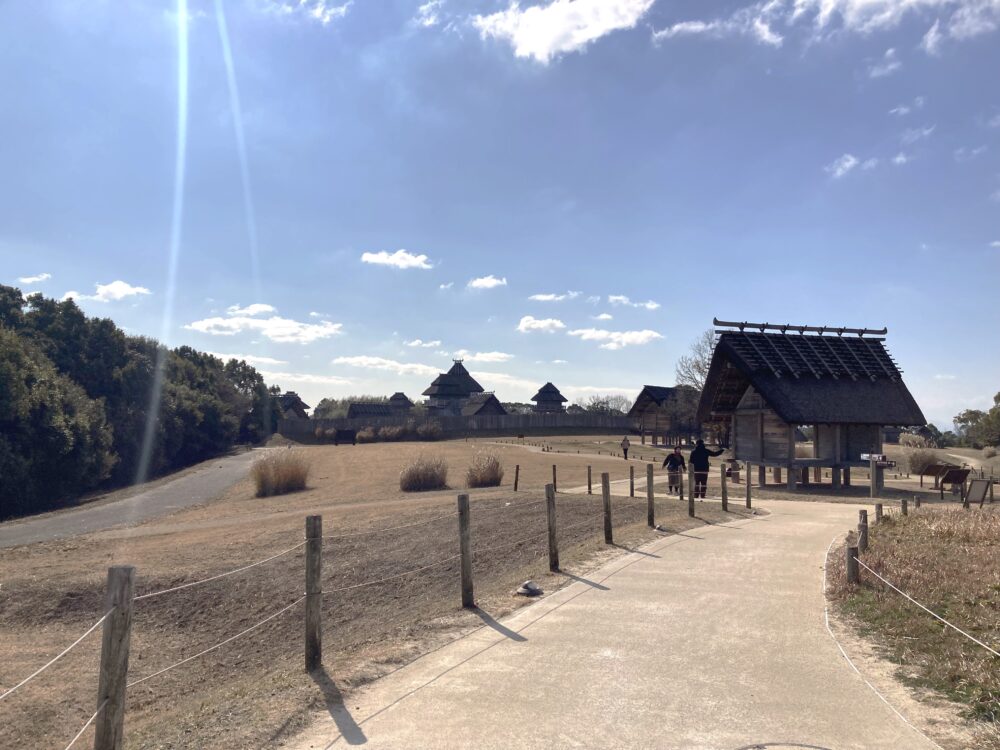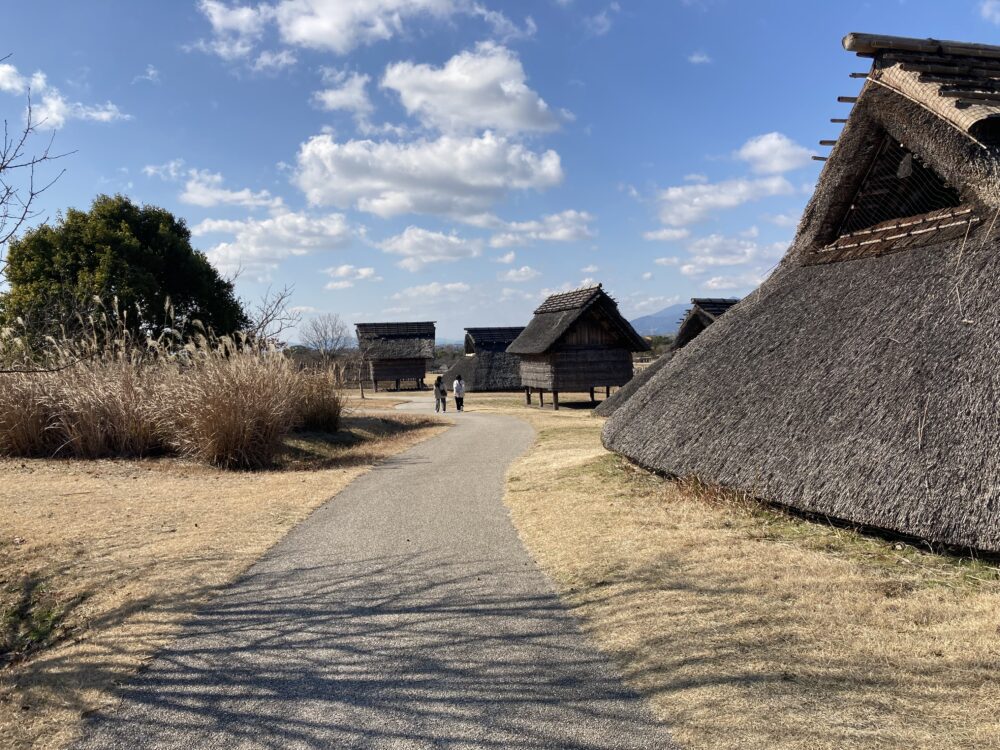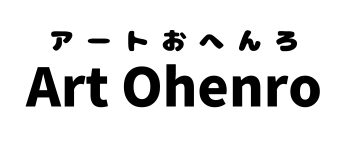The Yayoi period—more than 2,000 years ago.
The ruins stretch across a wide area covering both Yoshinogari Town and Kanzaki City in Saga. Many visitors may recognize the name from their history textbooks. Today, the site has been transformed into Yoshinogari Historical Park , where reconstructed buildings show what life looked like 2,000 years ago. Walking through the park, you can actually feel as if you’ve stepped back in time.
Excavations are still ongoing, and some areas are off-limits. But that makes it even more exciting—because you can sometimes catch a glimpse of real archaeological digs happening right before your eyes.
TOC
スポンサードリンク
The History of Yoshinogari
Early Yayoi Period (5th–4th Century BC)
Image source: © OpenStreetMap contributors Blue: Yoshinogari Historical Park grounds Orange: Villages Black bold lines: Moat
Let’s start with the time when Yoshinogari was still just a cluster of small villages.
In the southern area, there were several small settlements. One of the larger ones, about 2.5 hectares in size, was already surrounded by a protective moat.
What’s fascinating is what archaeologists found in this area: not only stone tools, shells, and animal bones, but also tools for making bronze weapons and ornaments . This shows that bronze production had already begun during this early stage.
What is a Jar Burial (Kamekanbo)?
Toward the later part of this period, a unique burial style called jar burial (kamekanbo) appeared. In this method, two large jars were joined together with clay, and the deceased was placed inside in a crouched position.
Over 3,100 jar burials have been excavated at Yoshinogari. This burial style was especially common in the Fukuoka and Saga regions and later spread widely during the Middle Yayoi period.
Yoshinogari Historical Park – Inside the North Burial Mound Exhibit Model of Jar Burial Middle Yayoi Period (2nd Century BC – 1st Century AD)
image source: © OpenStreetMap contributors Blue: Yoshinogari Historical Park grounds Orange: Villages Black bold lines: Moat Purple: Burial grounds
By this time, the Yoshinogari settlement had grown dramatically in scale. The moat-enclosed village expanded to more than 20 hectares , with clear zoning for houses (pit dwellings), warehouses, and other areas.
Yoshinogari Historical Park – Reconstructed Pit Dwellings The Jar Burial Rows
Burial customs also changed during this time. Instead of being scattered, jar burials began to line up neatly in rows. These are called jar burial rows (kamekanbo-retsu) .
At Yoshinogari, about 1,300 burials were arranged in long north-to-south rows, creating what looks like a collective cemetery.
Even more intriguing, some human remains showed missing skulls, bone fractures, and knife wounds. This suggests that conflicts and battles were taking place in the region during this era.
Yoshinogari Historical Park – Recreated Jar Burial Rows Yoshinogari Historical Park – Exhibit of Human Remains Without Skulls (Replica) The Rise of Burial Mounds – Signs of Powerful Leaders
During this time, special tombs began to appear—called burial mounds (funkyu-bo) . These were small hills of earth built over the graves of important people.
From these tombs, archaeologists have uncovered luxury items such as bronze swords and glass beads , showing that powerful leaders already existed in Yoshinogari. This is clear evidence that society was becoming more hierarchical and stratified .
Yoshinogari Historical Park – North Burial Mound Exhibit Late Yayoi Period (1st–3rd Century AD)
image source: © OpenStreetMap contributors Blue: Yoshinogari Historical Park grounds Orange: Villages Green: Inner compounds
This was the peak of Yoshinogari’s history .40 hectares , making it one of the largest in all of Japan.
Watchtowers, warehouses, ritual spaces, and residential areas were carefully organized, creating a truly advanced village. Among the highlights are the Southern Inner Compound (where the elite lived) and the Northern Inner Compound (used for religious ceremonies).
Today, visitors can explore full-scale reconstructions of these late Yayoi structures inside Yoshinogari Historical Park. What makes it especially exciting is that the reconstructions are built directly on top of the original ruins, giving you a real sense of standing exactly where history happened.
This period also overlaps with the era of Queen Himiko , the mysterious ruler described in the ancient Chinese text Records of the Wei . Many believe Yoshinogari may have had ties to the legendary Yamatai Kingdom , adding even more fascination to the site.
Yoshinogari Historical Park – Reconstructed Raised-Floor Warehouses The End of Yoshinogari
By the late 3rd century AD, Japan entered the Kofun period . At Yoshinogari, the protective moats were filled in, houses disappeared, and the once-thriving settlement gradually faded away.
In its place, kofun-style tombs (keyhole-shaped and rectangular burial mounds) were built, turning the former center of life into a burial ground.
Where did the people of Yoshinogari go? Why did the settlement vanish? No one knows for sure. But perhaps it marked the rise of a new ruling power in ancient Japan.
Must-See Highlights in Yoshinogari Historical Park – Reconstructed Buildings and Ruins
Now, let’s take a look at some of the main highlights inside the park.experience the atmosphere of ancient Japan .
The Southern Inner Compound – The “VIP Area” of the Settlement
View of the Southern Inner Compound from a Watchtower The Southern Inner Compound was the central area where the leaders of Yoshinogari lived during the late Yayoi period. Think of it as the VIP zone of the settlement .
This area was heavily protected with deep moats, tall wooden fences, and even four watchtowers . Clearly, this was no ordinary village neighborhood.
Archaeologists believe this was the residence of the chief, his family, and close retainers who governed the entire settlement. It was essentially the political and power center of Yoshinogari.
Climbing up one of the reconstructed watchtowers gives you a sweeping view of the central plaza below—it’s an absolutely breathtaking sight! The Northern Inner Compound – Sacred Center of Politics and Rituals
The Northern Inner Compound was one of the most sacred and important areas of Yoshinogari.political meetings and religious ceremonies . In other words, it was both the political heart and the spiritual hub of the Yayoi community.
▶The Main Shrine Hall
At the very center of the Northern Inner Compound stands the Main Shrine Hall , the largest building in the area.political councils on the second floor, and sacred rituals on the third .
▶Raised-Floor Residence (Home of the High Priest)
Among the sacred structures of the Northern Inner Compound, one building stands out as especially significant.residence of the high priest .
Yoshinogari Historical Park – Reconstructed Residence of the High Priest ▶Gates and Moats
The entrance to the Northern Inner Compound was not straight but bent in a zigzag (crank) shape , designed to make it difficult for intruders to rush inside.
Surrounding the entire compound were double moats and wooden fences , completely blocking outside views. The atmosphere here clearly tells you: “This was not a place for just anyone to enter.”
The Northern Burial Mound – A Monumental Cemetery of Yoshinogari
Right next to the Northern Inner Compound lies the Northern Burial Mound (hunkyu-bo), an impressive group cemetery built during the middle Yayoi period (around 2,200–2,100 years ago).
The mound measures about 40 meters north to south and 27 meters east to west —quite a massive size for its time. Inside, archaeologists discovered 14 jar burials (kamekanbo) , some containing grave goods such as bronze swords and glass beads .
▶Luxury Burials for the Elite
What’s even more surprising is that the inside of some jar coffins was coated with lacquer (or carbonized material) and cinnabar (mercury vermilion) .the top leaders or ruling elite of Yoshinogari .
▶Now Open as an Exhibition Facility
The Northern Burial Mound was first excavated, then reburied for preservation. In 2008, it was reopened and is now carefully preserved and displayed for visitors.
Inside the exhibition hall, you can learn in detail how the burial mound was built, how it was preserved, and why it was so important.advanced and sophisticated the Yayoi people truly were .
Is Yoshinogari Connected to the Legendary Yamatai Kingdom?
One of the biggest mysteries for Japanese history fans is: “Where was the Yamatai Kingdom located?” Yoshinogari Ruins in Saga Prefecture could be one of the strongest candidates.
In the ancient Chinese chronicle Records of the Three Kingdoms (Wei Zhi) , Queen Himiko of Yamatai is described as follows:
“She had a palace, watchtowers, and fortified fences, and was always attended by her servants.”
That description sounds almost identical to the Northern Inner Compound at Yoshinogari , with its watchtowers and fortified enclosures. Even more fascinating, the timeline matches perfectly: the 3rd century, the peak of Yoshinogari.
▶Signs of Conflict in Northern Kyushu
The Wei Zhi also records that the land of Wa (ancient Japan) was full of conflict until Himiko was made queen and brought peace.skeletons without skulls and bones with sword wounds , showing real evidence of battles. This matches the historical record almost too well.
▶Still No Final Proof—But Full of Imagination
Of course, no decisive evidence has yet been found to prove that Yoshinogari was the Yamatai Kingdom .
“Could the High Priest’s Residence here in the Northern Inner Compound have been the home of Queen Himiko herself?”
That kind of thought makes history come alive in the most exciting way.
Inside the High Priest’s Residence, Northern Inner Compound
Conclusion: Yoshinogari Is More Amazing Than You Think
In this guide, we explored Yoshinogari Historical Park , one of the largest Yayoi Period sites in Japan. The reconstructed moats, ancient settlements, and burial mounds are impressive, but there’s much more to see.
For example:
“South Village” – Experience the daily life of common people.Yayoi Life Experience Hall – Try hands-on activities like making magatama beads or fire-starting.Yayoi Open Field – A huge grassy area perfect for kids to run and play.
It’s a destination where both families and history fans can enjoy a full day.
The Park Is Huge—Really Huge
Yoshinogari is about three times larger than most visitors expect. On my first visit, I thought I could walk it all, but ended up taking over 20,000 steps—and still didn’t cover everything!
Luckily, there’s a shuttle bus inside the park , which is the best option if you want to save time and energy.
A Real “Time Travel” Experience
Walking through Yoshinogari Historical Park lets you feel the Yayoi Period with all your senses.
It’s hard to believe that 2,000 years ago—without cars, smartphones, or electricity—people had already built such an organized society. Experiencing that atmosphere in person makes history feel closer and more real.
If you ever get the chance, I highly recommend visiting Yoshinogari. You might just walk away thinking:“Wow, the Yayoi Period was way more exciting than I imagined!”
Visitor Information: Yoshinogari Historical Park
Location: 1843 Tade, Yoshinogari Town, Kanzaki District, Saga Prefecture, Japan
Access 15 minutes on foot from JR Yoshinogari-Kōen Station (North Exit)official website for other access options Admission Adults (15+) ¥460 (¥280 for groups of 20+)official website ) Hours April 1 – May 31: 9:00 AM – 5:00 PM Closed December 31, and the 3rd Monday & Tuesday of January
References ・Tadaaki Shichida, Series “Learning History” 115: The Capital of the Yamatai Period – Yoshinogari Ruins , Shinsensha, First Edition, First Printing, March 10, 2017
スポンサードリンク




Comments